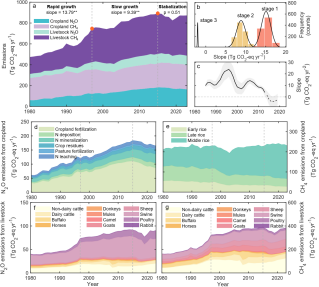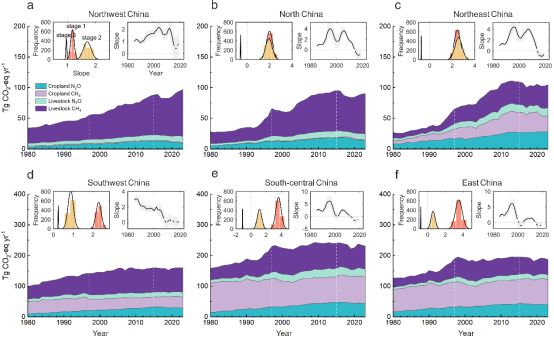Methane (CH₄) and nitrous oxide (N₂O) are critical greenhouse gases (GHGs) with 100-year global warming potentials 27 and 273 times higher than carbon dioxide (CO₂), respectively, exerting profound impacts on global climate change. Agriculture contributes approximately one-third of global methane emissions and half of anthropogenic nitrous oxide emissions, a contribution that may further increase with growing population and food demands. As a global agricultural powerhouse, China is also a major emitter of agricultural CH₄ and N₂O. However, long-standing limitations in estimation methodologies and data availability have resulted in substantial uncertainties in quantifying these emissions, hindering accurate understanding of their spatiotemporal dynamics and the formulation of science-based mitigation strategies.
To address this research gap, a collaborative team from Peking University, Zhejiang University, Sun Yat-sen University, the Institute of Atmospheric Physics at the Chinese Academy of Sciences, and other institutions developed a multi-method framework integrating emission factor methods, machine learning, and process-based models. This effort produced a long-term (1980–2023), high-resolution dataset of agricultural CH₄ and N₂O emissions in China. The study elucidates the spatiotemporal variations and drivers of emissions across sub-sectors (cropland CH₄, cropland N₂O, livestock CH₄, and livestock N₂O), evaluates the impacts of agricultural management improvements and policy adjustments over the past 44 years, and provides scientific foundations for future emission reduction policies.
Key Findings:
Total Emissions and Sectoral Contributions:
Over the past 44 years, China’s average annual agricultural non-CO₂ GHG emissions totaled 722.5 ± 102.3 million tons of CO₂-equivalent (Mt CO₂-eq), with livestock CH₄ contributing the largest share (41%), followed by cropland CH₄ (31%), cropland N₂O (18%), and livestock N₂O (10%). Spatially, emission hotspots are concentrated in densely populated regions such as East China, South Central China, and the Sichuan Basin (Figure 1).

Figure 1. Spatial distribution of agricultural methane (CH₄) and nitrous oxide (N₂O) emissions in China. Subplots (a)-(e) represent:
(a) Total emissions, (b) Cropland N₂O, (c) Cropland CH₄, (d) Livestock N₂O, (e) Livestock CH₄.
Temporal Trends:
Emissions exhibited a triphasic trajectory (Figure 2):
Phase 1 (1980–late 1990s): Rapid growth driven by agricultural expansion, notably in livestock CH₄ and cropland N₂O.
Phase 2 (late 1990s–mid-2010s): Slowed growth due to improved management practices, particularly in livestock emissions.
Phase 3 (mid-2010s–present): Stabilization of total emissions, attributed to reduced cropland N₂O emissions, reflecting progress in sustainable agriculture.

Figure 2. Temporal trends of agricultural CH₄ and N₂O emissions in China, 1980–2023.
1.Regional Disparities:
Emission trends varied markedly across regions (Figure 3):
East and South Central China: Stabilization since the late 1990s.
North, Northeast, and Southwest China: Gradual stabilization post-2010.
Northwest China: Continued growth driven by livestock CH₄ emissions.
These disparities underscore the need for region-specific mitigation strategies aligned with socioeconomic conditions and agricultural structures to balance food security and emission reduction.

Figure 3. Emission trajectory patterns of agricultural CH₄ and N₂O across six major geographic regions in China, 1980–2023.
Publication Details:
The study, titled “Recent stabilization of agricultural non-CO₂ greenhouse gas emissions in China,” was published in National Science Review. Yuanyi Gao and Zimeng Li (Ph.D. candidates at Peking University) are co-first authors, with Assistant Professor Songbai Hong (Peking University Shenzhen Graduate School of Urban Planning and Design) as corresponding author. Key collaborators include Prof. Wenping Yuan, Associate Prof. Xuhui Wang, and Researcher Yao Zhang (Peking University); Researcher Wen Zhang and Dr. Lijun Yu (Institute of Atmospheric Physics, Chinese Academy of Sciences); Researcher Jinfeng Chang (Zhejiang University); Associate Prof. Jing Wei and Dr. Shihua Li (Sun Yat-sen University).
Funding:
Supported by the National Natural Science Foundation of China (42471116, 41988101) and the Peking University BHP “Carbon and Climate” Ph.D. Student Weiming Scholarship (WM202412).
Article Link: https://doi.org/10.1093/nsr/nwaf040.
Images and text: Hong Songbai
Review: Hong Songbai